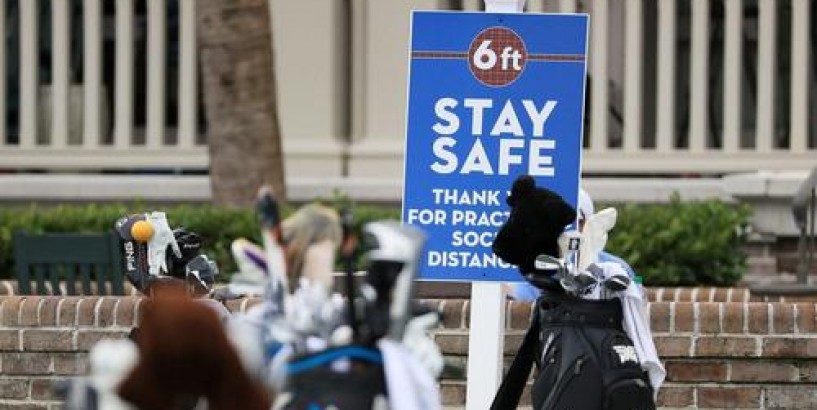The PGA Tour's new normal is starting to feel normal.
We're one month into the Tour's Return to Golf, with four events already in the books and thousands of travel miles logged within the "bubble." There have been several hits, a few misses, and plenty of takeaways from the action as golf remains at the forefront of sports that have found a way to resume competition amid a global pandemic.
Here's a look at some of the lessons we have learned so far, with a two-step of events in Ohio now on deck:
The bubble is neither static nor airtight
When the Tour set out its health and safety guidelines, the goal was to minimize risks - not eliminate them. The positive COVID-19 cases that began popping up among players and caddies, notably with five early-week withdrawals from the Travelers Championship, were an inevitability. How the Tour has responded and will continue to respond will be the key to keeping the tournament train rolling, as officials have been quick to adjust a number of guidelines ranging from frequency of tests to available options for players who do test positive.
The Tour remains every bit of a traveling circus, with players still renting homes in lieu of hotels, descending upon tournament venues from every corner of the country and going their separate ways each night once they arrive. Individual travel options will be on full display in the coming weeks, as players aren't afforded another Tour-sponsored charter until they head to the 3M Open at the end of the month. The onus will remain on adherence to existing rules, and subsequent positive tests and withdrawals are more a formality than a likelihood. But so far, the Tour has found a way to balance a variety of safety needs, new procedures and evolving data without toppling over.
Workday Charity Open: Full-field tee times | Full coverage
Optics matter
The spotlight shines brightly on golf these days, as most other U.S. professional sports remain in the preliminary phases of resuming competition. So when multiple players and caddies were seen casually fist-bumping and otherwise violating social-distancing protocols, especially at the first event back at Colonial, the world took note.
Initially, there may have been a false sense of security - that everyone on the ground was there because they had already tested negative for the virus. But while Nick Watney 's mid-week result at the RBC Heritage sent shockwaves through the sport, it also taught an important lesson that a negative result on Monday doesn't necessarily mean that a person is still negative on Friday.
The Tour has taken steps to address on-course behavior with players, and conduct has improved since the first event in Fort Worth. This past week in Detroit, the post-round norm was a tipped cap from the other side of the green in lieu of a fist bump or handshake, as players seem to be settling in to the norms of a new lifestyle on Tour that might be around for a while.
But in the interim, the fact remains that the world is watching, even if no fans are present. And the view from the camera lens remains critically important.
DeChambeau is the favorite to win every major, and here's why... The hottest players didn't lose a step during quarantine
Webb Simpson was one of the best players on Tour in the early part of 2020, notching a playoff victory in Phoenix in February. Bryson DeChambeau was already heating up before the Tour went into lockdown and his focus on bulk became even more laser-like. Both players have responded to an unexpected midseason break by winning events in the first month while racking up strong results in other tournaments. Even the relative outlier of the first four winners, Daniel Berger, was riding a par-or-better streak that dated back to October before he teed it up at Colonial.
Some stars have been slow to regain their form, notably Rory McIlroy and Jon Rahm, who remain 1-2 in the world rankings. But by and large, the biggest names in the game haven't just shown up for the Tour's return - they've found a way to thrive right out of the gates. And that means the pressures faced by those hoping to chase them down have only increased.
The meat of the season is fast approaching
There might still be a lingering sense of novelty for some players as the Tour hits a mid-July stretch, but there is no denying that some of the biggest events of the year are just around the corner.
The chances for tune-ups are quickly running out, as most players will get in at least one start at Muirfield Village over the next month before potentially teeing it up in a WGC event in Memphis at the end of the month. But we're only four weeks away from the year's first major, the PGA Championship at Harding Park, and from there it will be downhill through a torrid slate of significant events. Two weeks after the PGA will mark the start of the playoffs, with the U.S. Open a few weeks after that. Even if the Ryder Cup gets pushed back a year, as has been discussed but not confirmed, there will be few chances to take a breath from here until players head down Magnolia Lane for the Masters in November.
When the Tour first announced their revamped schedule for the 2020 season, there was essentially a circle drawn around the first four events. This was going to be something of a test run, done without fans present, to see if mid-pandemic operations were even possible. With all four events now in the rearview mirror, the Tour has answered the questions it initially posed, and the likelihood of an uninterrupted season the rest of the way grows stronger. If that's the case, the fun is about to begin.









